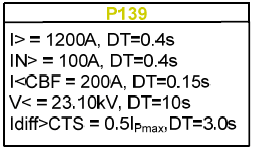Dear All,
Could you please mentioned the actual reason of the following false tripping of one healthy feeder due to a single line to ground fault on the adjacent feeder.
Details are as follows:
Both feeders are being fed from the same bus 33KV feeding each one one string of an offshore wind farm. They are adjacent to each other like feeder 1 and 2. Feeder 2 had SLG fault and it caused feeder 1 also tripped on the same time.
Faulty Feeder 2 : Offshore wind farm string with 7 turbines of 7MW each, 33 KV, total string cable length 10KM (Underground cable 3x1x800 Sq.mm CU/XLPE/STA/PVC), CT 1000/1 with Micom P139 relay.
Protection settings:

Healthy Feeder 1 which also tripped : Offshore wind farm string with 7 turbines of 7MW each, 33 KV, total string cable length 10KM (Underground cable 3x1x800 Sq.mm CU/XLPE/STA/PVC), CT 1000/1 with Micom P139 relay.
Protection settings:

To note that in another feeder it is connected a 315 kVA Y-Y earthing/auxiliary transformer with both neutral points directly earthed.
Could you please explain the actual reason and measures to be taken to avoid such false tripping. Could it be due to a sympathetic tripping event?
Best Regards.
Could you please mentioned the actual reason of the following false tripping of one healthy feeder due to a single line to ground fault on the adjacent feeder.
Details are as follows:
Both feeders are being fed from the same bus 33KV feeding each one one string of an offshore wind farm. They are adjacent to each other like feeder 1 and 2. Feeder 2 had SLG fault and it caused feeder 1 also tripped on the same time.
Faulty Feeder 2 : Offshore wind farm string with 7 turbines of 7MW each, 33 KV, total string cable length 10KM (Underground cable 3x1x800 Sq.mm CU/XLPE/STA/PVC), CT 1000/1 with Micom P139 relay.
Protection settings:

Healthy Feeder 1 which also tripped : Offshore wind farm string with 7 turbines of 7MW each, 33 KV, total string cable length 10KM (Underground cable 3x1x800 Sq.mm CU/XLPE/STA/PVC), CT 1000/1 with Micom P139 relay.
Protection settings:

To note that in another feeder it is connected a 315 kVA Y-Y earthing/auxiliary transformer with both neutral points directly earthed.
Could you please explain the actual reason and measures to be taken to avoid such false tripping. Could it be due to a sympathetic tripping event?
Best Regards.
